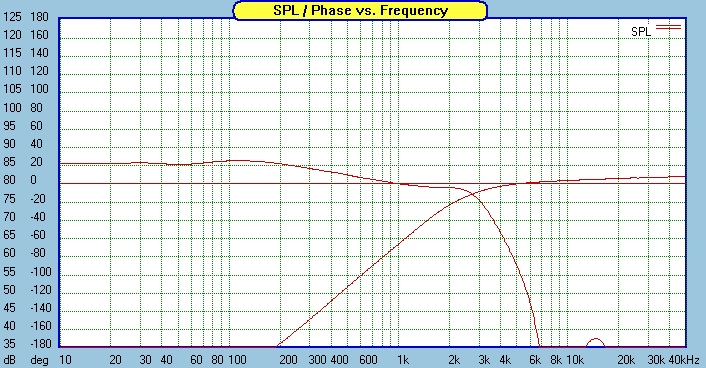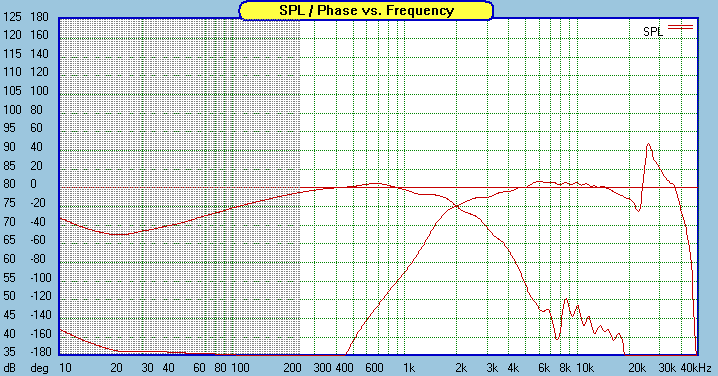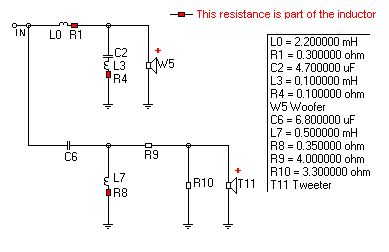Is it possible to create the same transfer function that zaph achieves passively for his seas all metal design (see below) using foobar + 3rd party plug-ins? With f00_dsp_xover, a pc can act as a 3 way xover with bessel, butterworth or chebychev topologies up to 10th order. Alternatively, if zaph's around, would he reccomend a different topology considering the greater flexibility, in terms of slope order, afforded by a pc crossover.
zaph's design
http://www.zaphaudio.com/audio-speaker17.html
foobar
http://www.foobar2000.org/
crossover plugin for foobar (not the only one)
http://xover.sourceforge.net/
I realise that this is a topic that half belongs in the digital forum but thought that other people may be having trouble sourcing or affording the components needed for a passive xo like me (I'm UK based).
zaph's design
http://www.zaphaudio.com/audio-speaker17.html
foobar
http://www.foobar2000.org/
crossover plugin for foobar (not the only one)
http://xover.sourceforge.net/
I realise that this is a topic that half belongs in the digital forum but thought that other people may be having trouble sourcing or affording the components needed for a passive xo like me (I'm UK based).
Interesting. I've been reading up about the L18 and re-reading Zaph's own comments, and looking a his graphs, I have a relevant question.
The graph that is retaining my attention is the following: http://zaphaudio.com/audio-speaker17-measured-response-individual.gif
It shows the MEASURED frequency response curves for each of the drivers WITH the X-over in place. My question is the peek at 8khz and the spikes that follow it audible? Consider that the peaks exist between 45 and 50db while the rest of the response curve is at 80db, is that something to worry about, is it audible? Would Bi-amping with an active x-over help get rid of that +8khz noise? Is the L15 design "cleaner" in that respect?
Ok I lied, I have many questions!
The graph that is retaining my attention is the following: http://zaphaudio.com/audio-speaker17-measured-response-individual.gif
It shows the MEASURED frequency response curves for each of the drivers WITH the X-over in place. My question is the peek at 8khz and the spikes that follow it audible? Consider that the peaks exist between 45 and 50db while the rest of the response curve is at 80db, is that something to worry about, is it audible? Would Bi-amping with an active x-over help get rid of that +8khz noise? Is the L15 design "cleaner" in that respect?
Ok I lied, I have many questions!
I think Zaph uses about -40dB as the audible noise "floor" looking at the harmonic distortion graphs of his drivers.
I've only read the one subjective review about the L15 design and in no way did the reviewer describe the sound as edgy or metal.
I would therefore assume the approx -32dB for the 9KHz peak (relative to the tweeter output at same frequency) is subdued enough not to be noticed.
Tony Gee in his Progress design used a simple 2nd order electrical network on the L26 which has a peak at 4KHz. the 2nd order without a notch won't tame the breakup. Tony however didn't mind with that design.
I suppose therefore going overboard with a 4th order electrical (which would eliminate it) isn't required.
David.
I've only read the one subjective review about the L15 design and in no way did the reviewer describe the sound as edgy or metal.
I would therefore assume the approx -32dB for the 9KHz peak (relative to the tweeter output at same frequency) is subdued enough not to be noticed.
Tony Gee in his Progress design used a simple 2nd order electrical network on the L26 which has a peak at 4KHz. the 2nd order without a notch won't tame the breakup. Tony however didn't mind with that design.
I suppose therefore going overboard with a 4th order electrical (which would eliminate it) isn't required.
David.
Hmmm, intersting..
I just built Zaph's bargain aluminum MTMs, and my latest thinking (besides wanting a new preamp and poweramp) is to figure out digital crossovers. The software is there, and people are using it (http://drc.wildgooses.com/wiki/User:Birkinshawc). It should be easy, you'd just need an amp (and pre?) for each driver. Maybe we should start with a full ranger.
I was thinking, get a frequency plot for the driver, and then try and get the computer to do a equalization and crossover. Should be simple. Unfortunately, nothing ever is.
I recently built a pair of zigmahornets with dave merrill's dca4 drivers. Hopefully, later next month (when I'm around), I'll get them measured and set up the computer. I wont need any extra amps that way: the zigmas are already very enjoyable.
If anyone has experience with this, please share. If anyone has done any eq or xo, how did it turn out? My brief experience with computer dsp didn't sound too good for the lows and highs. It has potential though.
I just built Zaph's bargain aluminum MTMs, and my latest thinking (besides wanting a new preamp and poweramp) is to figure out digital crossovers. The software is there, and people are using it (http://drc.wildgooses.com/wiki/User:Birkinshawc). It should be easy, you'd just need an amp (and pre?) for each driver. Maybe we should start with a full ranger.
I was thinking, get a frequency plot for the driver, and then try and get the computer to do a equalization and crossover. Should be simple. Unfortunately, nothing ever is.
I recently built a pair of zigmahornets with dave merrill's dca4 drivers. Hopefully, later next month (when I'm around), I'll get them measured and set up the computer. I wont need any extra amps that way: the zigmas are already very enjoyable.
If anyone has experience with this, please share. If anyone has done any eq or xo, how did it turn out? My brief experience with computer dsp didn't sound too good for the lows and highs. It has potential though.
btw, to do a computer based xo, you need a lot of outs on your soundcard. I'm using a delta 1010lt, with 8 analog outs. It's a decent card, not bad, but not the best.
My plan, maybe this winter, is to do an open baffle (or no baffle), with a computer based xo and eq, three way, maybe four. Shoot for the moon. Stay tuned.
My plan, maybe this winter, is to do an open baffle (or no baffle), with a computer based xo and eq, three way, maybe four. Shoot for the moon. Stay tuned.
for your computer based xo, you can also use those free soft :
crossvolver is a FIR 4 ways xo
LS filter is a IIR 4 ways xo
I'm planning to do another tool to listen/compare many kinds of crossovers in real time (FIR, IIR bessel, butterworth, LR) while moving vertically to listen to lobes and irregularities
crossvolver is a FIR 4 ways xo
LS filter is a IIR 4 ways xo
I'm planning to do another tool to listen/compare many kinds of crossovers in real time (FIR, IIR bessel, butterworth, LR) while moving vertically to listen to lobes and irregularities
Hi,
Zaph's crossover is near 4th order L/R acoustic with
some assymetry because of the relative driver offsets.
The above is an approximation but effectively true if the
shape of the c/o region is the same an octave either
side of the crossover point (and the BSC lower down).
Consequently you can use higher order but overdamped
filters, e.g. 6th order than approximates 4th order in the
crossover region.

and

Further suppression of the 8khz stuff is possible but note this will
not affect the drivers raw response effect on distortion products.
Which is why the 8khz stuff is crossover wise "off the radar".
 /sreten.
/sreten.
Zaph's crossover is near 4th order L/R acoustic with
some assymetry because of the relative driver offsets.
The above is an approximation but effectively true if the
shape of the c/o region is the same an octave either
side of the crossover point (and the BSC lower down).
Consequently you can use higher order but overdamped
filters, e.g. 6th order than approximates 4th order in the
crossover region.

and

Further suppression of the 8khz stuff is possible but note this will
not affect the drivers raw response effect on distortion products.
Which is why the 8khz stuff is crossover wise "off the radar".
Thanks sreten for an enlightening post. Just to make sure I've got this right: using foobar xover plugins, the lowest q filter I can implement is a Bessel so I'm considering a 4th order Bessel (electrical) arranged in a "phase match" steup which is described here http://www.rane.com/note147.html . It is said to have "good flatness as well as the best polar response." With this high order slope, I was hoping to crossover about 1.8kHz about which both drivers start to roll off slightly. I was never particularly naive about how difficult it would be to design a good crossover but I didn't think it would be this tricky so any suggestions at all would be much appreciated.
Hi,
I'll add some notes referencing the two graphs shown and the c/o:

A) note the 1st graph is highly asymmetric whilst the 2nd is ~ symmetric.
B) the 1st graph shows the baffle step built in to the c/o for the bass mid.
C) the bass unit c/o is 1st order for BS combined with a notch filter,
electrically this is an elliptical filter, but the target is ~ 4th order L/R
in the crossover region.
D) the tweeter c/o is electrically second order, this combines with the
natural roll-off to give again ~ 4th order L/R in the crossover region.
E) note that unusually the acoustic response of the bass unit around
the crossover point is rolling off slower than the electrical response.
THe rane paper effectively describes the properties of a 4th order
bessel acoustic alignment - this is not a good idea compared
to a approximate 4th order L/R acoustic alignment with the
elliptical suppression of the bass units peak above the c/o point.
(For these particular drivers)
You are indeed correct c/o design is a complicated business -
especially for drivers like the Seas bass unit - there is great deal
of elegance in Zaphs design - which generally speaking cannot
be replicated using standard electrical filter functions - because
the raw responses of the drivers in box is not considered.
The use of higher order slopes to avoid the notch filter is not
a good idea IMO - you end up with more phase wrap over
the crossover region.
The ideal crossover is probably 2nd order L/R acoustic, but
achieving this acoustic response is also a complicated business
and for particular drivers may be not possible / not a good idea.
 /sreten.
/sreten.
I'll add some notes referencing the two graphs shown and the c/o:

A) note the 1st graph is highly asymmetric whilst the 2nd is ~ symmetric.
B) the 1st graph shows the baffle step built in to the c/o for the bass mid.
C) the bass unit c/o is 1st order for BS combined with a notch filter,
electrically this is an elliptical filter, but the target is ~ 4th order L/R
in the crossover region.
D) the tweeter c/o is electrically second order, this combines with the
natural roll-off to give again ~ 4th order L/R in the crossover region.
E) note that unusually the acoustic response of the bass unit around
the crossover point is rolling off slower than the electrical response.
THe rane paper effectively describes the properties of a 4th order
bessel acoustic alignment - this is not a good idea compared
to a approximate 4th order L/R acoustic alignment with the
elliptical suppression of the bass units peak above the c/o point.
(For these particular drivers)
You are indeed correct c/o design is a complicated business -
especially for drivers like the Seas bass unit - there is great deal
of elegance in Zaphs design - which generally speaking cannot
be replicated using standard electrical filter functions - because
the raw responses of the drivers in box is not considered.
The use of higher order slopes to avoid the notch filter is not
a good idea IMO - you end up with more phase wrap over
the crossover region.
The ideal crossover is probably 2nd order L/R acoustic, but
achieving this acoustic response is also a complicated business
and for particular drivers may be not possible / not a good idea.
jlo said:for your computer based xo, you can also use those free soft :
crossvolver is a FIR 4 ways xo
LS filter is a IIR 4 ways xo
I'm planning to do another tool to listen/compare many kinds of crossovers in real time (FIR, IIR bessel, butterworth, LR) while moving vertically to listen to lobes and irregularities
Hi, very interesting software!
If I remember well, Foobar has a VST host plugin, so your software could run as VST plugin in Foobar?
I downloaded your Crossvolver, but I had problems under Vista, so I can't see ASIO configurations.
Suppose I have six ASIO channels and want to use Foobar: how does it work?
- Status
- This old topic is closed. If you want to reopen this topic, contact a moderator using the "Report Post" button.
- Home
- Loudspeakers
- Multi-Way
- digital crossover for zaph's L18/27tbfcg